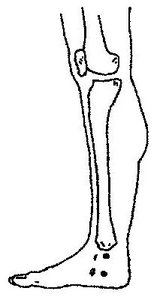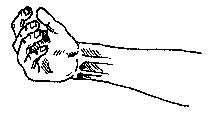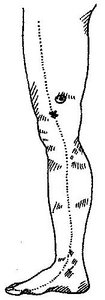Physicians of old have recognized the importance of tending the spirit in order to effectively treat disease. In particular, the Neijing (Yellow Emperor's Classic of Internal Medicine), the oldest extant Chinese medical text (500-300 BC), purports that in order to treat illness, one must first establish with the patient's spirit.
In Oriental medicine, the acupuncture needle is often seen as the instrument of containing the spirit because the needles are inserted into discrete acupuncture points, each of which is said to control specific physiological functions of the body down to the cellular level - indeed, what we might think of as the innate wisdom or spirit of the body. However, Oriental medicine also recognizes that before a practitioner can insert a needle in someone, another form of spirit connecting is also optimal. Whether it be guided imagery, eye contact, a handshake, or the ability to listen and be present, satisfying medicine for both practitioner and patient requires the possibility of meaningful interaction that allows a deeper, soulful, spiritual encounter. It is the medicine of the past and the new millennium.
Needling acupuncture points is a powerful avenue for achieving this connection. As the Spiritual Pivot (Lingshu) tells us, "If you should want to treat illness, there is nothing so good as the needle." The Three Treasures diagnostic paradigm also reminds us that of the three treasures (jing, qi and shen), the spirit (shen) must be treated first. It must be balanced, rooted and secured prior to the manipulation of qi, for it is indeed our core substrate.
There are several ways to treat the spirit by needling acupuncture points with specific energetics. One particular approach I have incorporated follows the ancient tenet that "blood is the material basis of the human spirit." It is the basis of our essence and our mental and emotional activities. Thus, by regulating the blood, the spirit can be tangibly addressed.
Many points affect the blood. The following five points are among my favorites. I will address their locations (if they are unique), their energetics, and specific needle techniques that can be used to treat the spirit by treating the blood.
PC6 (Neiguan) - Inner Gate: My favorite point in this approach, neiguan is the major point to move stagnant qi anywhere in the body, particularly the upper jiao. As such, it has the ability to decongest stagnant liver qi and move the qi of the upper jiao, thereby expanding the diaphragm, broadening the chest, and draining excess stuck energy off of the upper jiao, including stagnant emotional energy. Puncture the point perpendicularly 0.5-1.0 inches, or apply deep dispersives to the point as needed several times a day. As a longitudinal luo point, it regulates the qi and blood of the heart; opens the heart orifice; calms the spirit and mind; and benefits the brain, emotions and mental state. In this case, needle the point obliquely 0.3-0.5 inches proximally. In either case, magnetic bracelets on the point perform these functions well.
 Figure 1: Japanese and Chinese locations for KI6 (Zhaohai).
KI6 (Zhaohai) - Shining Sea: KI6 is my second favorite point of choice for assisting the spirit by way of treating the blood. KI6 is perhaps to Japanese acupuncture what ST36 is to Chinese acupuncture. It is the primary point to nourish the yin, a vital blood component. It calms the mind; cools the blood; strengthens the adrenal glands; and supports the sympathetic nervous system. It is useful for chronic illness, stress and trauma, which typically have an emotional (spirit) component.
Figure 1: Japanese and Chinese locations for KI6 (Zhaohai).
KI6 (Zhaohai) - Shining Sea: KI6 is my second favorite point of choice for assisting the spirit by way of treating the blood. KI6 is perhaps to Japanese acupuncture what ST36 is to Chinese acupuncture. It is the primary point to nourish the yin, a vital blood component. It calms the mind; cools the blood; strengthens the adrenal glands; and supports the sympathetic nervous system. It is useful for chronic illness, stress and trauma, which typically have an emotional (spirit) component.
My preferred location of KI6 is typically referred to as Japanese KI6 (or one of the alternate Chinese locations). This location is one cun directly below the medial malleolus at the junction of the red and white skin. Puncture the point with a #1 or 36-gauge needle transversely toward the heel, inserting it 0.1-0.2 inches. Do not obtain qi on the point; simply insert it toward the heel. This is considered a tonification technique, as it is inserted in the direction of the meridian (see Figure 1).
KI1 (Yongquan) - Gushing Spring: KI1 is one of the most powerful points to treat the spirit and blood. Physiologically, it is the jing (well) point, wood point and sedation point of the kidney meridian. It tonifies yin; clears heat; subdues wind; calms the mind; restores consciousness; nourishes the kidney; and suppresses liver fire. In Japanese acupuncture, it is the primary point to adjust and treat any vascular disturbance such as blood stagnation, blood pressure problems, or any other circulatory problem.
Palpate the point first to optimize its energetics. This point is extremely tender on most patients. Patients can be taught how to massage the point daily for several minutes to treat themselves. To consolidate the effect, it should be needled by a practitioner. Use a #1 or 36-gauge needle with an insertion tube to assist in inserting the needle painlessly. Puncture perpendicularly 0.3-0.5 inches. Many health problems, both emotional and physical, can be resolved when treating this point due to its intimate connection to the blood.
 Figure 2: Japanese and Chinese locations for HT7 (Shenmen).
HT7 (Shenmen) - Spirit Gate: HT7 is a primary point for treating the spirit. As the shu (stream) point, source point, earth point and sedation point on the heart meridian, it quiets the heart and calms the spirit. By virtue of these effects, as the classics say, "When the heart is serene, all pain is negligible." As such, it is a primary point for pain, emotional problems, anxiety and insomnia. Puncture the point perpendicularly 0.3-0.5 inches. The point may be located according to the standard Chinese location, or alternatively in a Japanese location in which the needle is simply inserted underneath the tendon of the flexor carpi ulnaris muscle towards the Chinese HT7 (see Figure 2). Obtain little or no qi depending on your style of treatment. This is a handy technique when it is difficult to needle the Chinese location (in the articular regions of the psiform and ulna, in the depression on the radial side of the ulna), as sometimes there are arthritic bone deformities or tight tendons in the area. HT7 and KI6 synergistically work well together to coordinate the strong relationship between the heart and kidney, the blood and spirit.
Figure 2: Japanese and Chinese locations for HT7 (Shenmen).
HT7 (Shenmen) - Spirit Gate: HT7 is a primary point for treating the spirit. As the shu (stream) point, source point, earth point and sedation point on the heart meridian, it quiets the heart and calms the spirit. By virtue of these effects, as the classics say, "When the heart is serene, all pain is negligible." As such, it is a primary point for pain, emotional problems, anxiety and insomnia. Puncture the point perpendicularly 0.3-0.5 inches. The point may be located according to the standard Chinese location, or alternatively in a Japanese location in which the needle is simply inserted underneath the tendon of the flexor carpi ulnaris muscle towards the Chinese HT7 (see Figure 2). Obtain little or no qi depending on your style of treatment. This is a handy technique when it is difficult to needle the Chinese location (in the articular regions of the psiform and ulna, in the depression on the radial side of the ulna), as sometimes there are arthritic bone deformities or tight tendons in the area. HT7 and KI6 synergistically work well together to coordinate the strong relationship between the heart and kidney, the blood and spirit.
 Figure 3: Chinese and Japanese locations for SP10 (Xuehai).
SP10 (Xuehai) - Sea of Blood: SP10 is a major point that affects the blood. Energetically, it is a sea of blood, meaning it has a profound influence on the blood. It is a point of intersection of the chong meridian, the extraordinary vessel which is also a reservoir of blood. Clinically, one of the major actions of SP10 is that diagnostically, via palpation, it is indicative of blood stagnation anywhere in the body. It cools heat in the blood and moves, tonifies and strengthens it. It perfuses the lower abdomen and activates blood. Generally, it is extremely tender when palpated, especially in the Japanese location. For this location, cup your right palm to the patient's left knee with the thumb on its medial side and the other four fingers directed proximally. The point is about one inch above where your thumb rests. It is a large area, more medial than the Chinese location (see Figure 3). The point may be punctured bilaterally 0.7-1.2 inches.
Figure 3: Chinese and Japanese locations for SP10 (Xuehai).
SP10 (Xuehai) - Sea of Blood: SP10 is a major point that affects the blood. Energetically, it is a sea of blood, meaning it has a profound influence on the blood. It is a point of intersection of the chong meridian, the extraordinary vessel which is also a reservoir of blood. Clinically, one of the major actions of SP10 is that diagnostically, via palpation, it is indicative of blood stagnation anywhere in the body. It cools heat in the blood and moves, tonifies and strengthens it. It perfuses the lower abdomen and activates blood. Generally, it is extremely tender when palpated, especially in the Japanese location. For this location, cup your right palm to the patient's left knee with the thumb on its medial side and the other four fingers directed proximally. The point is about one inch above where your thumb rests. It is a large area, more medial than the Chinese location (see Figure 3). The point may be punctured bilaterally 0.7-1.2 inches.
The selected use of these points as a core part of your acupuncture prescription can assist you in seamlessly treating the spirit by treating the blood. As we can see, this is surely a strength of the Oriental medical paradigm.
Click here for previous articles by Skya Abbate, DOM.




